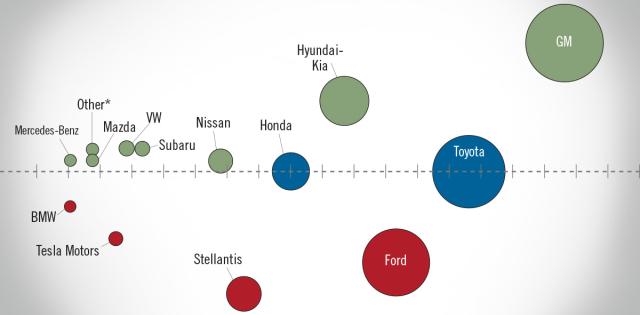The article below is sourced from Bloomberg Wire Service. The views and opinions expressed in this story are those of the Bloomberg Wire Service and do not necessarily reflect the official policy or position of NADA.
Mercedes-Benz Group AG’s earnings plummeted 34% in the first quarter, weighed down by model changes and sluggish demand for electric vehicles.
Adjusted group earnings before interest and tax dropped to €3.6 billion ($3.9 billion), Mercedes said Tuesday. The company, which left its outlook for the year unchanged, said its carmaking margin was 9% — below its annual target — hit by high costs of model upgrades.
Shares declined as much as 3.5% in early trading, paring gains over the past year to about 4.9%.
The German luxury-car maker has run into problems with its strategy to bolster profits with more top-end cars, where sales were down more than a quarter. In the first three months of the year, consumers held off on purchases of G-Class off-roaders and E-Class sedans as they waited for new or updated versions of the vehicles to come out.
“We’re not content with the results from the first quarter,” Chief Financial Officer Harald Wilhelm said on a call with reporters, adding that he expects sales to pick up over the course of the year as availability improves.
Mercedes also expects the share of its most expensive vehicles to rise in the second half of the year. While the company expects the market in China to improve, the US was the only region where it sees “solid momentum for sales and demand.”
Volkswagen AG and Stellantis NV also reported slower starts to the year. Like Mercedes, the weaker sales were driven in part by model changeovers.
A widespread slump in demand for EVs also hit Mercedes, which saw orders of all-electric models slow. Supply bottlenecks added to the challenges, hitting production of its GLC and E-Class vehicles. Mercedes said the blockage is easing.
What Bloomberg Intelligence Says:
Mercedes’ Car 1Q adjusted-Ebit margin of 9% (90 bps below our expectations) suggests soft 1Q results across the auto industry, though it was offset by strong free cash of €2.2 billion, boosted by lower capex and positive working capital. Cars’ 1Q supply constraints on GLC and E-class were well flagged and should ease from 2Q to improve volume and mix, explaining the 10-12% full-year margin target reiteration. Pricing and a weak mix away from high-end remain a risk.
— Michael Dean, BI automotive analyst
In February, the company walked back its EV sales targets, forecasting that the share of fully electric and plug-in hybrid vehicles will remain roughly flat this year at 19% to 21% of overall sales.
Mercedes, though, said its pricing remained at a high level in the first quarter, despite pressure from price cuts led by Tesla Inc. The company added that it wants to “hold and defend” pricing at current levels.
For more stories like this, bookmark www.NADAheadlines.org as a favorite in the browser of your choice and subscribe to our newsletter here:











